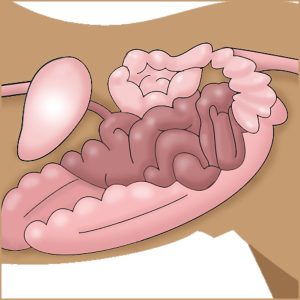
Havoc in the Hindgut
Your horse is a home
The digestive tract of your horse is home to millions of microorganisms that aid in the digestion of feedstuffs. The sheer size of the microbial population shows their importance to your horse’s health. Leading equine nutritionist David Frape once wrote “…the bacteria cells in the digestive tract of the horse number more than ten times all the tissues cells in the body.”
Think about it: There are more microbes in the gut of your horse than all the individual tissue cells that make up your horse’s body! The microbial population is incredibly vast, but also very sensitive; therefore, they must be carefully maintained to protect against changes that can lead to digestive upset, colic and laminitis.
Huddle in the hindgut
While microorganisms reside in nearly all parts of your horse’s digestive tract, the vast majority of them set up shop in your horse’s hindgut (cecum and large intestine). Because your horse does not secrete enzymes or digestive juices to break down the feed that enters the hindgut, the task of digestion is left to the resident microbes. They do this through a process called fermentation. The microbes use some of the fermented nutrients for themselves, while others are absorbed by the horse. Each individual microbe has its own specialty when it comes to fermentation. Some break down proteins, others starches and simple carbohydrates, while still others break down the more complex carbohydrates or fibers. The types and numbers of microbes living in the hindgut are based on the variety of feedstuffs found in your horse’s diet. Because of this, the balance of the microbial population can be affected by what, when and how you feed your horse.
Abrupt feed changes are a microbial home wrecker
Abrupt changes in your horse’s feeding program can negatively affect the microbial population, but how? When you abruptly change what you feed, when you feed or how much you feed, it alters the quantity and type of nutrients available to the microbes. When confronted with an abrupt change, some microbes die off because they no longer have access to the nutrients they need to survive. Meanwhile, other microbes readily adapt to the change, allowing their population to increase. In some cases, the surviving microbes produce large quantities of fermentation byproducts that alter the pH in the hindgut. This makes the environment even more unsuitable for other beneficial microbes and the imbalance becomes worse. It is this disruption in the balance of the microbial population and the increased acidity in the hindgut that can lead to digestive upset, colic and laminitis. The good news is you can protect your horse against microbial imbalances by following good management practices.
Eight Easy Feeding Tips to Prevent Microbial Imbalances
- Provide an unlimited source of clean water at all times.
- Feed a consistent diet and make all changes in concentrates, hay and supplements slowly—over a week to 10 days—to allow the microbial population enough time to adapt to new compounds.
- Feed a high-quality fiber (like hay) and offer it free choice whenever possible.
- Feed concentrates as small, frequent meals. Do not feed more than 4 pounds of concentrate per meal.
- Maintain a consistent feeding schedule. Microbes become accustomed to “eating” at certain times of the day, so not feeding your horse on time can cause the beneficial microbes to die off. If too many microbes die off at once, the hindgut will become unbalanced.
- Keep all feeds and supplements in a horse-proof container or feed room to avoid accidental overeating.
- Never feed tainted or moldy concentrates, hay or supplements.
- Supplement your horse with high-quality probiotics during times of stress or after antibiotic use. Probiotics can help repopulate the hindgut with “good” microbes.


